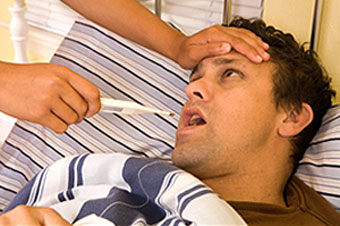What to Do
Hand Washing
Hand washing is the most important step for preventing infection. When caring for someone, always wash or disinfect your hands:
- Before eating and preparing food
- Before you begin caring for the person
- Between any changes of gloves
- After you touch any body fluids like saliva, urine, blood, or drainage from a wound
- After you finish caring for the person
- After playing with pets and small children
For a Fever

If the person you care for has a fever, take these steps to help control the fever. Controlling a fever will make the person more comfortable.
- Encourage rest and limit physical activity.
- Remove or reduce the amount of clothing on the person’s body. Do not let the person shiver. (Shivering increases body heat). Remove extra blankets or bed covers, have the person wear light-weight and dry bed clothes.
- Keep the temperature of the rooms in the home above 70º degrees so the person is comfortable and not shivering.
- Offer the person eight to ten, 8-ounce glasses of fluids each day, unless the person has heart or kidney disease. The body needs more fluids as it tries to cool down.
- Offer water, fruit juice, or broth.
- Check with the doctor if you are unsure about how much a person can drink.
- Avoid caffeine drinks such as tea, regular soda, and coffee.
- A person with a fever often has a dry mouth. Offer water or ice chips frequently. Let the person rinse their mouth out often.
For a Wound Infection

If you suspect an infection of a wound, cleanse any open area on the skin with mild soap and water, call the doctor and explain the signs you see.
You can also take steps to keep the wound clean and reduce the chance of the infection spreading to other body sites.
Basic Wound Care Tips
- First, always follow the instructions from your doctor on wound care.
- Wash your hands thoroughly for at least 15 seconds before caring for a wound.
- Put on a pair of disposable gloves. Remove the old dressing. Look at the dressing for drainage and note the amount, color, and odor. Write down what you see in your care diary.
- Remove your gloves and re-wash your hands. Apply a new pair of gloves.
- Cleanse the skin around the wound with mild soap and water or cleanser as ordered by the doctor. Use a clean wash cloth with each cleansing.
- Cleanse the wound, wipe in the direction from the wound out toward the surrounding skin
- Use a new clean section of the cloth each time you wipe. This prevents you from wiping over dirty skin and then re-touching the wound itself.
- Use a separate dry cloth to gently dry the skin, wiping in the same direction you used to clean the wound.
- If the doctor has given instructions to apply any solution or ointment to a wound, apply it gently, avoid rubbing. Use a sterile gauze pad to apply solution or ointment. Take special care not to touch the side of the gauze that will cover the wound.
- If you see black threads or metal closures in an incision, these are sutures. Never try to remove a suture. These are to be removed in the doctor’s office. See our future lesson on Care of Stitches (Sutures).
- Cover the wound with a new clean dressing, just like the one removed. Tape it securely so it completely covers the wound. Do not tape entirely around an arm or leg as it will cut off circulation.
- When finished, dispose of soiled supplies and gloves in a plastic trash or grocery bag and wash your hands.

For a Urine Infection
- Have the person drink about eight to ten 8-ounce glasses of liquids, if able.
- Have the person clean carefully around their private parts after passing urine. A woman should always clean from front to back, moving the wash cloth from the perineum (front) towards the rectum (back), using a clean part of the wash cloth with each swipe.